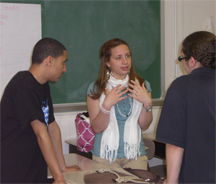Carousel Brainstorming
 The Carousel Brainstorming strategy is easy to implement. Each cooperative group walks up to an open-ended question posted on chart paper, discusses it, brainstorms answers or solutions, and writes down responses within a given amount of time. When the teacher “carousels” students, or rotates the groups to new locations, they repeat the exercise with a new question. This time students must read the responses from the previous group(s) before they begin to write down new ideas.
The Carousel Brainstorming strategy is easy to implement. Each cooperative group walks up to an open-ended question posted on chart paper, discusses it, brainstorms answers or solutions, and writes down responses within a given amount of time. When the teacher “carousels” students, or rotates the groups to new locations, they repeat the exercise with a new question. This time students must read the responses from the previous group(s) before they begin to write down new ideas.
Materials
- Different colored markers
- Chart paper
- Masking tape (Tape chart paper at eye level in different locations around the room)
Preparation
1. The teacher generates open-ended questions for the class. Open-ended questions provoke a higher level response from students and can easily be written. Instead of writing a question starting with “who, what, when, where, and why” try the following:
- In what ways…
- Describe in detail…
- For what reasons….
- Generate a list of….
For a more detailed discussion of questioning, please see our Open-Ended Questions post.
2. Or, if time permits, the teacher along with the students can generate questions collectively.
3. Numbering each, the teacher places the question separately on the top of chart paper for students to answer.
4. Use masking tape to post the questions on the walls. Allow ample room around each chart, so the group can congregate around it.
5. Assign each cooperative group with a number that corresponds to a question. Give each group a different colored marker. This will identify their answers on all charts.
6. Explain the strategy to the class: Each cooperative group will walk up to the same number as allocated to their cooperative group. They will be given a short period of time to answer the question.
7. All groups are to discuss their ideas/responses to the question. Responses are written down on the chart paper by the recorder.
8. After a specific time frame (3-5 minutes), each group rotates to the next sheet with a  different question. Rotate the role of the recorder. Each group takes the marker with it, as all responses with that colored marker serve to identify the work of each particular cooperative group for the teacher. Groups cannot reiterate previously stated responses, but they can continue to add new ideas to the list. Repeat the same procedure for the remaining questions until the system is exhausted. Using this format, groups “carousel” around the room, rotating among the questions.
different question. Rotate the role of the recorder. Each group takes the marker with it, as all responses with that colored marker serve to identify the work of each particular cooperative group for the teacher. Groups cannot reiterate previously stated responses, but they can continue to add new ideas to the list. Repeat the same procedure for the remaining questions until the system is exhausted. Using this format, groups “carousel” around the room, rotating among the questions.
9. Students are given an additional minute for each time they rotate to a new question. This extra time will give them the opportunity to read what other groups have written. Even though they are not allowed to write the same thing another group has written, they are allowed to make comments on the side of the sheet to extend an answer or simply add marginalia or notations.
10. Now that the strategy has been explained to the class, the teacher institutes negotiable contracting of criteria for assessment. Ask students to place themselves in the position of the teacher. Now that they have a good idea of the task, what criteria should be used for grading the strategy? Allow students to brainstorm criteria in their cooperative groups. The teacher lists the results on large chart paper. Please see our post on Negotiable Contracting. The following are sample ideas of criteria for assessment:
- Listen and respond to others in your cooperative group
- Make meaningful contributions
- Encourage peers to explain themselves if they are not clear at first
- Write down the idea clearly and succinctly for others to read
Activity
1. Each cooperative group is now assigned to walk over to a different sheet of chart paper with a question written on it. They follow the procedure as described above.
2. Following the activity, the instructor asks the class to discuss the responses that are posted.
a. English Language Arts: Samples may include but are not limited to:
- Describe in detail how the environment has an effect on the main character of the book.
- Explain specifically the conflicts or problems that your young adolescent faces.
- Describe the tensions between the main character and the other characters in the book.
- Explain in detail which of these strengths you find admirable, and which weaknesses you can relate to and understand.
b. Social Studies: Samples may include but are not limited to:
- For what reasons did tensions evolve between the two great empires?
- In what ways did the cultures of the various civilizations clash?
- Describe how the leadership qualities of the great men resulted in conflict?
c. Mathematics: When studying how different graphs present information differently: Samples include but are not limited to:
- In what ways do the styles of these graphs differ?
- Describe in detail the strength of Style A graphing as opposed to Style B graphing?
- If you wanted to stress a certain subject or topic, explain specifically which style of graphing you would choose.
d. Foreign Language
- Generate as many words beginning with a c that creates a “CH” sound.
- etc…..
(c) 2012 Andi Stix, Ed.D
 Please share with us your experiences with Carousel Brainstorming in the classroom or at a staff meeting. Describe what you learned. Explain in detail any variations that other viewers would appreciate knowing.
Please share with us your experiences with Carousel Brainstorming in the classroom or at a staff meeting. Describe what you learned. Explain in detail any variations that other viewers would appreciate knowing.
Andi Stix is an educational consultant & coach who specializes in differentiation, interactive learning, writing across the curriculum, classroom coaching, and gifted education. For further information on her specialties or social media, please email her on the Contact page.





